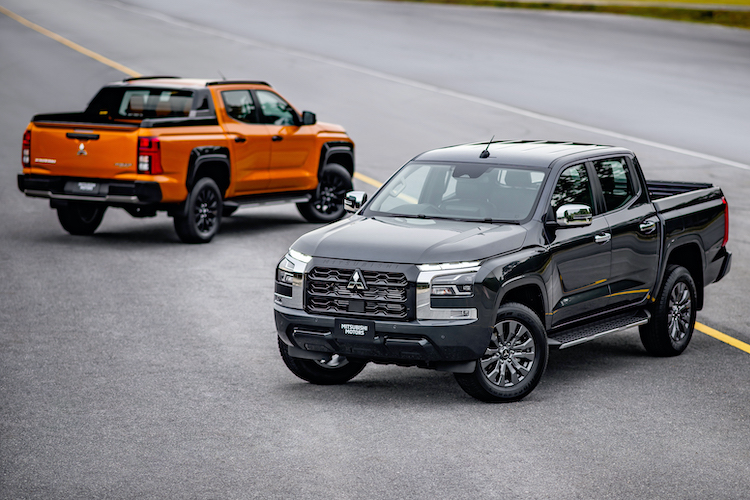
Sales of the all-new Mitsubishi Triton one-tonne pick-up have commenced in Thailand and the vehicle will soon begin rolling out to markets in the ASEAN and Oceania regions.
It is also scheduled for launch in Japan in early 2024 for the first time in 12 years.
Local specification and pricing have yet to be confirmed by the distributor but the new Triton is expected to arrive here in early 2024, and pre orders may be available online in late 2023 according to a Mitsubishi Motors New Zealand spokesperson.
Now in its sixth generation, it is the first full redesign of the Triton one-tonne ute in nearly a decade.
Mitsubishi Motors Corporation (MMC) says the key features of the Triton are:
- A newly developed ladder frame and a newly developed engine that achieves both higher output and improved environmental performance
- A newly developed suspension that provides excellent ride comfort and steering stability, and Super Select 4WD-II system and upgraded drive modes
- A front face with a strong sense of presence and reliability, a wide and robust styling, and a classy interior offering excellent functionality and operability
- Significantly improved safety and comfort for a wide range of purposes, from business to personal use
The Triton comes in three configurations; a double-cab with two rows of seats, a single-cab, and a club-cab with cargo space behind the front seats.
MMC says it has a newly developed 2.4L diesel turbo engine that significantly boosts environmental performance and power. The ladder frame, suspension and other main components have been newly developed and road performance has been greatly enhanced through features such as upgraded drive mode and electronically controlled Active Yaw Control (AYC) combined with Super Select 4WD-II system.
With the adoption of Adaptive Cruise Control (ACC) among other new safety features and emergency support using connected car technology, safety and comfort has been greatly improved not only in terms of the truck’s hardware, but also in terms of its software says MMC.
The 4N16 diesel engine comes in three different output specifications. The high-output version is equipped with a new turbo charger and new combustion system, providing a maximum output of 150 kW and maximum torque of 470 Nm from 1500 rpm. There are two versions of the standard specification – one with an engine that has a maximum output of 135 kW and a maximum torque of 430 Nm, and one with an engine that has a maximum output of 110 kW and a maximum torque of 330 Nm. Both have a variable geometry turbo charger that performs variable control of turbine capacity.
The Triton comes with either a six-speed automatic transmission with the Sports mode from the previous model, or a six-speed manual transmission with shift-by-wire that reduces vibration directly transmitted from the engine and improving comfort.
The 4WD system enables the driver to easily shift to 4WD mode while driving by using a dial selector. The Triton continues to use Mitsubishi Motors’ Super Select 4WD-II and Easy Select 4WD systems, and Super Select 4WD-II is equipped with a centre torque sensing Limited Slip Differential (LSD) that distributes driving force at a ratio of 40% to the front and 60% to the rear, thus ensuring both traction performance and cornering performance.
Models equipped with the Super Select 4WD-II system can select from the four options of 2H (rear-wheel drive), 4H (full-time four-wheel drive), 4HLc (locked centre differential) and 4LLc (locked centre differential with lower gears), and have seven drive modes including on-road modes, an increase over the four off-road modes of the previous model.
Along with Normal mode that is available in all four-wheel drive modes, 2H offers Eco mode for prioritization of economy, 4H offers Gravel and Snow modes, 4HLc offers Mud and Sand modes for traction performance, while 4LLc provides Rock mode, allowing drivers to select the optimum drive mode for any road condition. The 4WD modes available for selection in vehicles equipped with Easy Select 4WD are 2H (rear-wheel drive), 4H (locked centre differential), and 4L (for low-gear driving).
MMC says the AYC is newly adopted for models equipped with the Super Select 4WD-II system. It improves cornering performance by applying light braking to the inside front wheel when cornering. Both the two-wheel and four-wheel drive models are equipped with active LSD (brake control type). By applying the brake to a spinning wheel and distributing the driving torque to wheels gripping the road surface, it improves safety on slippery surfaces while also providing a sporty driving experience.
Active Stability & Traction Control (ASTC) that improves stability on winding roads is standard on all models. Other systems include Hill Descent Control (HDC), which maintains a set speed on downhill slopes to enable driving with confidence, and Hill Start Assist (HSA), which prevents roll-back in hill starts.
The newly developed suspension retains a double wishbone structure for the front suspension. The upper suspension mounting arm has been moved higher to increase the stroke by 20mm, providing improved road-holding and ride comfort. The rear suspension provides greater ride comfort while retaining its strength and uses a lighter leaf spring system together with thicker shock absorbers.








